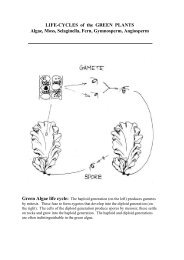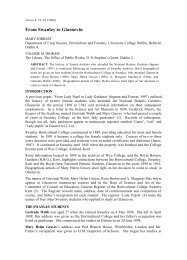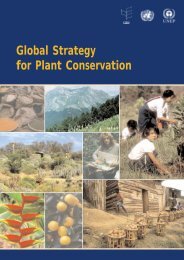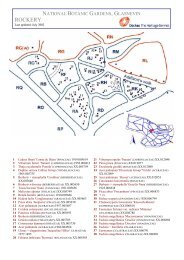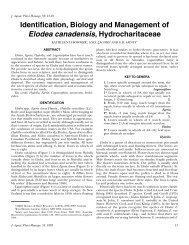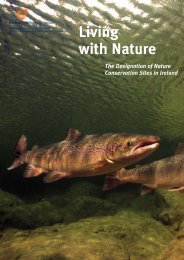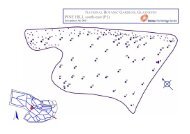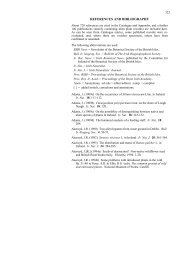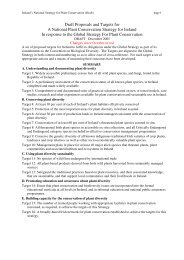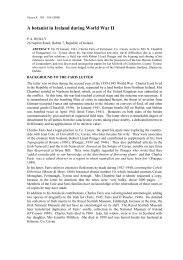MYRICACEAE FAGACEAE - National Botanic Gardens
MYRICACEAE FAGACEAE - National Botanic Gardens
MYRICACEAE FAGACEAE - National Botanic Gardens
You also want an ePaper? Increase the reach of your titles
YUMPU automatically turns print PDFs into web optimized ePapers that Google loves.
` FLORA OF COUNTY WATERFORD 71<br />
<strong>MYRICACEAE</strong><br />
Myrica gale L. Bog-myrtle<br />
Native. Marshes, bogs, fens and reedbeds. Surprisingly rare. All records are: the Clonea area<br />
(X39, 1899, R.L. Praeger); patch in bog and several bushes in damp field, both on east side of<br />
Annestown Stream and a number of bushes on west side of Annestown Stream, between<br />
Annestown and Dunhill Castle (X5099 and S5000, 1963, I.K. Ferguson – 2006, PRG and M.J.<br />
Stribley); marsh west of Tramore (S5503, 1967, I.K. Ferguson); amongst Common Reed on the<br />
west side of Belle Lake (S6604 and S6605, 1999, PRG); abundant in field on west side of the<br />
R675, Coolgower (S6006, 2001, PRG) and eight bushes in heathy area by road, Killineen West<br />
(X2999, PRG, 2003).<br />
<strong>FAGACEAE</strong><br />
Fagus sylvatica L. Beech<br />
Woods, hedges, walls, wooded river<br />
and stream banks. Beech is not<br />
thought to be native to Ireland. Date of<br />
introduction not known, but possibly<br />
brought in by the Normans. Absent<br />
from most of the coast and mountain<br />
ranges except for sheltered valleys.<br />
Even though most records are<br />
probably of planted trees, it is often<br />
found self-sown.<br />
First record: self-sown in wild<br />
ground, Co. Waterford, A contribution<br />
to the flora of Ireland (Praeger, 1934).<br />
2<br />
1<br />
0<br />
9<br />
8<br />
9<br />
Key:<br />
2000-2007<br />
1987-1999<br />
1900-1986<br />
1746-1899<br />
2 3<br />
4 5<br />
6 7<br />
Fagus sylvatica var. cuprea Copper Beech<br />
There are only three records, all of single self-sown trees: conifer plantation at Coolfinn<br />
(S4715, 2002, I.P. Green); steep bank between river and road, Colligan Beg (X2298, 2002, I.P.<br />
Green); wooded road bank of the River Blackwater, Rincrew (X0981, 2007, PRG).<br />
Nothofagus alpina (Poepp. & Endl.) Oerst. Rauli<br />
Rauli has been planted around the edges of two conifer plantations in the county. These trees<br />
are now mature and have produced offspring: side of track on Tower Hill, Portlaw (S4418,<br />
2001, I.P. Green) and edge of moorland on roadside, Reanaviddoge (X2288, 2003, PRG).<br />
Castanea sativa Mill. Sweet Chestnut<br />
Woods, hedges, and the edge of<br />
2<br />
conifer plantations. Most records are<br />
probably of planted trees, but I have<br />
1<br />
occasionally seen Sweet Chestnut selfsown<br />
in woods.<br />
0<br />
R S<br />
First record: Lismore, X09P, 1950s,<br />
WX<br />
C. Longfield.<br />
9<br />
8<br />
9<br />
0<br />
1<br />
Key:<br />
2000-2007<br />
1987-1999<br />
1900-1986<br />
1746-1899<br />
2 3<br />
4 5<br />
6 7<br />
0<br />
1
72 Paul Green<br />
Quercus petraea (Matt.) Liebl. Sessile Oak<br />
Native. Sessile Oak is often the<br />
dominant tree in the few deciduous<br />
woodlands left in the county. It is also<br />
found along wooded river and stream<br />
banks and occasionally around the<br />
edge of conifer plantations that were<br />
once mixed woodland. Rarely found in<br />
hedges.<br />
First record: Lismore, X09P, 1950s,<br />
C. Longfield. It is surprising that I<br />
have not been able to trace any records<br />
before then.<br />
Quercus x rosacea Bechst.<br />
2<br />
1<br />
0<br />
9<br />
8<br />
9<br />
0<br />
1<br />
2<br />
1<br />
0<br />
9<br />
8<br />
9<br />
Key:<br />
2000-2007<br />
1987-1999<br />
1900-1986<br />
1746-1899<br />
2 3<br />
4 5<br />
6 7<br />
Key:<br />
2000-2007<br />
1987-1999<br />
1900-1986<br />
1746-1899<br />
2 3<br />
4 5<br />
6 7<br />
Native. Quercus x rosacea is the<br />
hybrid between Sessile and<br />
Pedunculate Oak. Found in mixed<br />
woodland and wooded river and<br />
stream banks. As some forms of the<br />
hybrid closely resemble Pedunculate<br />
Oak, it is probably more frequent than<br />
the map suggests.<br />
First record: S21 and S41, after 1950,<br />
New Atlas.<br />
Quercus robur L. Pedunculate Oak<br />
Native. Often found in hedges, also<br />
2<br />
woods and wooded stream and river<br />
banks and coastal scrub and very<br />
1<br />
occasionally on rock ledges in the<br />
coums of the Comeragh Mountains.<br />
First record: Mine Head, X28, 1882, 0<br />
H.C. Hart.<br />
9<br />
8<br />
9<br />
Quercus rubra L. Red Oak<br />
Probably planted in all cases but not always easy to tell. All records are associated with conifer<br />
plantations where it is often planted around the boundary and along the edge of the rides. All<br />
records of planted trees: amongst trees on edge of Ballyshonock Reservoir (S4509); edge of<br />
plantation, Dalligan Bridge (X3098); edge of plantation, Knockadullaun (R9704); Rock Wood,<br />
Cappagh (X1896) – all 1997, G.A. Crouch and PRG and edge of plantation, Mocollop<br />
0<br />
0<br />
1<br />
1<br />
Key:<br />
2000-2007<br />
1987-1999<br />
1900-1986<br />
1746-1899<br />
2 3<br />
4 5<br />
6 7
` FLORA OF COUNTY WATERFORD 73<br />
(W9399, 2003, PRG). Possibly self-sown: north edge of plantation along roadside,<br />
Curraheenavoher Hill (S1817); one tree in plantation, Lacken (X2796) and single tree on side<br />
of ride in plantation, Landscape (S2922) – all 2002, I.P. Green.<br />
Quercus cerris L. Turkey Oak<br />
2<br />
1<br />
0<br />
9<br />
8<br />
Turkey Oak can be found regenerating<br />
in woods, on road banks, in hedges, on<br />
a road verge at the base of a wall, on a<br />
wall and on wooded rocky areas on the<br />
coast west of Cheekpoint. Also found<br />
as a planted tree in woods, on hedge<br />
banks and as a specimen tree in fields.<br />
Turkey Oak can sporadically be semideciduous,<br />
holding its leaves<br />
throughout winter. There are only<br />
three records prior to 1997.<br />
First record: As a planted tree, S30<br />
and S51, after 1950, New Atlas. As self-sown trees, regenerating in wooded valley at Newtown<br />
Cove, Newtown (X5699, 1964, I.K. Ferguson – 2003,WFS field meeting).<br />
Quercus ilex L. Evergreen Oak<br />
A rare tree in the wild in Ireland. In<br />
the far east of the county Evergreen<br />
Oak can be found established in rocky<br />
woodland and wooded river banks and<br />
very occasionally self-sown on walls<br />
around People’s Park, Waterford<br />
(S6111, 2002, D. McGrath). Away<br />
from this part of the county it is a<br />
planted tree.<br />
First record: regenerating in rocky<br />
coastal woodland on the north side of<br />
Knockavelish Head, S6904, 1997,<br />
G.A. Crouch and PRG.<br />
BETULACEAE<br />
Betula pendula Roth Silver Birch<br />
2<br />
1<br />
0<br />
9<br />
8<br />
9<br />
9<br />
R S<br />
WX<br />
0<br />
R S<br />
WX<br />
0<br />
1<br />
1<br />
Key:<br />
2000-2007<br />
1987-1999<br />
1900-1986<br />
1746-1899<br />
2 3<br />
4 5<br />
6 7<br />
Key:<br />
2000-2007<br />
1987-1999<br />
1900-1986<br />
1746-1899<br />
2 3<br />
4 5<br />
6 7<br />
2<br />
1<br />
0<br />
9<br />
8<br />
9<br />
R S<br />
WX<br />
0<br />
1<br />
Key:<br />
2000-2007<br />
1987-1999<br />
1900-1986<br />
1746-1899<br />
2 3<br />
4 5<br />
6 7<br />
Native? Woods, conifer plantations,<br />
hedges, wooded river and stream<br />
banks. Surprisingly rare and often just<br />
a single tree is seen. Some recorded<br />
trees may have been planted and there<br />
is a possibility that Silver Birch is not<br />
native to the county as it is so rare.<br />
First record: Lismore, X09P, 1950s,<br />
C. Longfield. The New Atlas also has<br />
records for S20 and S30 for after 1950.
74 Paul Green<br />
Betula pubescens Ehrh. Downy Birch<br />
Native. Woods, conifer plantations,<br />
hedges, wooded river and stream<br />
banks, walls and the edge of marshes.<br />
Absent from majority of the coast and<br />
much of the heather moorland in the<br />
mountain ranges. Often planted around<br />
the margins of conifer plantations.<br />
First record: listed in Irish<br />
Topographical Botany (Praeger,<br />
1901).<br />
Alnus incana (L.) Moench Grey Alder<br />
A rare escape in Ireland. I have only found Grey Alder twice in the county: self-sown trees in<br />
the marsh and reedbed on the west shore of Belle Lake (S6604, 1999) and a single tree selfsown<br />
on waste ground at Knocklucas (S2121, 2004), parent trees in nearby garden.<br />
Alnus glutinosa (L.) Gaertn. Alder<br />
2<br />
1<br />
0<br />
9<br />
8<br />
9<br />
0<br />
1<br />
Key:<br />
2000-2007<br />
1987-1999<br />
1900-1986<br />
1746-1899<br />
2 3<br />
4 5<br />
6 7<br />
2<br />
1<br />
0<br />
9<br />
8<br />
9<br />
Key:<br />
2000-2007<br />
1987-1999<br />
1900-1986<br />
1746-1899<br />
2 3<br />
4 5<br />
6 7<br />
Native. Most common along banks of<br />
rivers and streams, also damp<br />
woodland, hedges, edges of marshes,<br />
walls by rivers and the margins of<br />
ponds, loughs and lakes. In the<br />
mountain ranges only found in the<br />
wooded river valleys. Alder is now<br />
being used for mass planting instead of<br />
conifers on many of the marshes and<br />
bogs in the county.<br />
First record: west of Clonmel, S11 or<br />
S12, 1897, R.L. Praeger.<br />
Alnus cordata (Loisel.) Duby Italian Alder<br />
A rare escape in Ireland. The only Co. Waterford record is of a single self-sown tree on<br />
Kilmolash Bridge (X1394, 2004, A.C. Leslie), parent trees in neighbouring garden.<br />
Alnus rubra Bong Red Alder<br />
In Ireland rare and always planted expect for the following which is the first Irish record of a<br />
self-sown Red Alder: a single tree in damp grassland near the shore of Kilmaloo Lough<br />
(X1281, 2002, I.P. Green), parent trees planted nearby.<br />
Carpinus betulus L. Hornbeam<br />
The only records of self-sown trees are from woodland on the north side of Knockavelish Head<br />
(S6904, 1997, G.A. Crouch and PRG); wooded area on the north side of the River Blackwater,<br />
Carrigane (W9299, 2003, PRG) and wooded road bank, Mocollop (W9399, 2006, BSBI field<br />
meeting). All other records I suspect to have been planted: mixed woodland, Faithlegg (S6713,<br />
1997, G.A. Crouch and PRG); edge of conifer plantation, Villierstown (X1093, 2000, PRG and<br />
0<br />
1
` FLORA OF COUNTY WATERFORD 75<br />
M.L. Stephens); woodland along right bank of the River Blackwater, Rincrew (X08V, 2001,<br />
I.P. Green); woodland, Curraghmore (S4315 and S4415, 2002, PRG); roadside hedge,<br />
Aughmore (S3318, 2003, PRG); roadside hedges, Snugborough (X0692, 2003 and X0592,<br />
2004, PRG); two trees in roadside hedge, Killineen West (X2999, 2004, PRG).<br />
Corylus avellana L. Hazel<br />
Native. Woods, hedges, wooded<br />
stream and river banks, rock faces, and<br />
disused railways. A common species<br />
of many of the wooded valleys.<br />
Absent from most of the high ground<br />
of the mountain ranges, can be found<br />
growing in rock crevices in a couple of<br />
the coums. Confined to wooded river<br />
valleys on the coast.<br />
First record: Co. Waterford, 1878, J.<br />
Neale.<br />
AIZOACEAE<br />
Carpobrotus edulis (L.) N.E. Br. Hottentot-fig<br />
A rare garden escape or discard. Patch on top of sea-cliffs, Ardoginna (X1677, 2004, PRG and<br />
J.C. Wallace); top of beach, Dungarvan (X2793, 2004, PRG), this patch disappeared during the<br />
following winter. I have not seen plants at either of these sites flowering.<br />
Carpobrotus edulis var. rubescens Druce<br />
There is only one site of this variety of Hottentot-fig with pinkish-purple petals: large patch on<br />
top of the cliffs over-looking Garrarus Cove (X5498, 1993, E. Fitzgerald – 2004, PRG).<br />
CHENOPODIACEAE<br />
Chenopodium vulvaria L. Stinking Goosefoot<br />
Extinct. The only record is from Tramore (S50, before 1866, S. Madden). Strangely the New<br />
Atlas lists no records for Ireland.<br />
Chenopodium rubrum L. Red Goosefoot<br />
2<br />
1<br />
0<br />
9<br />
8<br />
9<br />
0<br />
G.A. Crouch and PRG.<br />
1<br />
2<br />
1<br />
0<br />
9<br />
8<br />
9<br />
Key:<br />
2000-2007<br />
1987-1999<br />
1900-1986<br />
1746-1899<br />
2 3<br />
4 5<br />
6 7<br />
0<br />
1<br />
Key:<br />
2000-2007<br />
1987-1999<br />
1900-1986<br />
1746-1899<br />
2 3<br />
4 5<br />
6 7<br />
Native. Dried-up margins of loughs,<br />
reservoirs and riverbeds, manure<br />
heaps, areas poached by cattle in damp<br />
fields, cultivated and waste ground. A<br />
species that has increased greatly in<br />
Ireland since the 1962 Atlas. Around<br />
the receding margins of reservoirs and<br />
loughs the plants are small, as they do<br />
not have the chance to grow until well<br />
into the summer.<br />
First record: on heaps of soil by car<br />
park, Clonea Lower, X3194, 1997,
76 Paul Green<br />
Chenopodium ficifolium Sm. Fig-leaved Goosefoot<br />
Roadsides, waste and cultivated<br />
ground and rubbish tips. Many of the<br />
records have been made from maize<br />
and sugar beet fields. The only record<br />
before 2000 besides W.W.<br />
Newbould’s record is of three plants<br />
on the roadside of Ballyshonock<br />
Bridge (S4509, 1997, G.A. Crouch<br />
and PRG – still there 2000, I.P. and<br />
P.R. Green).<br />
First record: believed to have been<br />
seen near Waterford before 1866 by<br />
W.W. Newbould.<br />
2<br />
1<br />
0<br />
9<br />
8<br />
9<br />
Key:<br />
2000-2007<br />
1987-1999<br />
1900-1986<br />
1746-1899<br />
2 3<br />
4 5<br />
6 7<br />
Chenopodium bonus-henricus L. Good-King-Henry<br />
The only records for this garden herb are: three miles west of Cappoquin from a place called<br />
Modeshel (S00 or X09, 1905, E.H. Bowers, DBN) and a single clump on the roadside of<br />
junction of Lombard’s Cross Roads (X0781, 2005, PRG and M.L. Stephens).<br />
Chenopodium album L. Fat-hen<br />
Native. Roadsides, disturbed areas,<br />
2<br />
rubbish tips, manure heaps, beaches,<br />
waste and cultivated ground. Often<br />
1<br />
forming large stands on waste ground<br />
and on the side of newly constructed<br />
0<br />
roads.<br />
First record: Dunmore East, S60,<br />
9<br />
1897, R.L. Praeger.<br />
8<br />
9<br />
0<br />
1<br />
Key:<br />
2000-2007<br />
1987-1999<br />
1900-1986<br />
1746-1899<br />
Atriplex prostrata Boucher ex DC.<br />
Native. Roadsides, disturbed areas,<br />
2<br />
rubbish tips, manure heaps, beaches,<br />
Spear-leaved Orache<br />
saltmarshes, waste and cultivated<br />
ground. A species that seems to be on<br />
the increase.<br />
1<br />
First record: recorded as growing in<br />
Co. Waterford, Contributions towards<br />
0<br />
a Cybele Hibernica (Moore and More, 9<br />
1866).<br />
Key:<br />
R S<br />
WX<br />
2 3<br />
4 5<br />
6 7<br />
8<br />
9<br />
0<br />
0<br />
1<br />
1<br />
2000-2007<br />
1987-1999<br />
1900-1986<br />
1746-1899<br />
2 3<br />
4 5<br />
6 7
` FLORA OF COUNTY WATERFORD 77<br />
Atriplex glabriuscula Edmondston Babington’s Orache<br />
2<br />
1<br />
0<br />
9<br />
8<br />
9<br />
1901).<br />
R S<br />
WX<br />
0<br />
1<br />
Key:<br />
2000-2007<br />
1987-1999<br />
1900-1986<br />
1746-1899<br />
2 3<br />
4 5<br />
6 7<br />
Native. A species found at the top of<br />
beaches, base of sea-cliffs and around<br />
the margins of saltmarshes.<br />
Babington’s Orache can be found<br />
inland a short way along tidal rivers.<br />
[The New Atlas has records for S30<br />
and S40, which are inland squares.<br />
These are likely to be errors made<br />
when converting the old Irish grid to<br />
that used today.]<br />
First record: listed in Irish<br />
Topographical Botany (Praeger,<br />
Atriplex x taschereaui Stace Taschereau’s Orache<br />
Native. Taschereau’s Orache is a hybrid between Babington’s and Long-stalked Orache. I have<br />
not seen it growing with either parent in the county. Plentiful just above the high tide line of<br />
the River Suir at Ballynakill (S6311, 2002, I.P. and P.R. Green and D. McGrath – 2003, conf.<br />
J.R. Akeroyd) and little on the River Suir at Faithlegg (S6612, 2003, PRG). Also found in<br />
abundance on either side of the tidal stretch of the Ballycanvan Stream (S6509, S6609 and<br />
S6510, 2002, I.P. and P.R. Green and D. McGrath).<br />
Atriplex longipes Drejer Long-stalked Orache<br />
Native. Not known from Ireland until three plants were found on the margin of a brackish pond<br />
on Little Island (S6511, 2001, PRG – conf. J.R. Akeroyd, DBN – 2003, T. Curtis). There is an<br />
unconfirmed record from a saltmarsh on the banks of the River Suir opposite Little Island<br />
(S6311, 1990, R.N. Goodwillie). A search there in 2002 by D. McGrath, I.P. Green and myself<br />
failed in finding any Long-stalked Orache.<br />
Atriplex patula L. Common Orache<br />
Native. Roadsides, disturbed areas,<br />
2<br />
rubbish tips, manure heaps, beaches,<br />
upper parts of saltmarshes, waste and<br />
1<br />
cultivated ground. Often growing with<br />
Spear-leaved Orache. Absent from the<br />
mountain ranges.<br />
0<br />
First record: waste ground, Waterford,<br />
S51 or S61, 1899, R.L. Praeger, DBN.<br />
9<br />
8<br />
9<br />
Key:<br />
2000-2007<br />
1987-1999<br />
1900-1986<br />
1746-1899<br />
2 3<br />
4 5<br />
6 7<br />
Atriplex littoralis L. Grass-leaved Orache<br />
Native. A rare species on the Irish coast. All county records are: Dunmore East (S6800, 1971,<br />
H.J. Killick); single plant on edge of saltmarsh, Tramore (S5901, 1997, G.A. Crouch and<br />
PRG); scattered plants on edge of saltmarsh and along north side of Tramore Burrow (S6000<br />
0<br />
1
78 Paul Green<br />
and S6100, 2003, PRG and J.C. Wallace); waste area, Black Knob, Dunmore East (X6999,<br />
1998, PRG – 2004, M. O’Conor).<br />
Atriplex laciniata L. Frosted Orache<br />
Native. Frosted Orache can be found at<br />
2<br />
the top of sand and shingle beaches, in<br />
one sandy churchyard on the coast and<br />
1<br />
occasionally on the drift-line of<br />
0<br />
R S<br />
saltmarshes. Populations are often<br />
small and very sporadic in occurrence.<br />
WX<br />
First record: S50, 1962 Atlas.<br />
9<br />
8<br />
9<br />
0<br />
1<br />
Key:<br />
2000-2007<br />
1987-1999<br />
1900-1986<br />
1746-1899<br />
2 3<br />
4 5<br />
6 7<br />
Atriplex portulacoides L. Sea-purslane<br />
Native. Saltmarshes, sea-cliffs, banks<br />
of tidal rivers, walls on the coast and<br />
very rarely roadsides by the sea.<br />
Forming large stands on saltmarshes<br />
where it is often submerged by high<br />
tides. The only place Sea-purslane is<br />
found along the River Suir is a small<br />
saltmarsh at Gracedieu (S5714, 2002,<br />
PRG).<br />
First record: Tramore, S50 or S60,<br />
Flora Hibernica (Mackay, 1836).<br />
2<br />
1<br />
0<br />
9<br />
8<br />
9<br />
R S<br />
WX<br />
Key:<br />
2000-2007<br />
1987-1999<br />
1900-1986<br />
1746-1899<br />
2 3<br />
4 5<br />
6 7<br />
Beta vulgaris subsp. maritima (L.) Arcang. Sea Beet<br />
Native. Saltmarshes, sea-cliffs, top of<br />
2<br />
beaches, banks of tidal rivers, walls on<br />
the coast and very rarely roadsides by<br />
1<br />
the sea. Sea Beet can also be found on<br />
waste ground by the coast.<br />
0<br />
R S<br />
First record: Mine Head, X28, 1882,<br />
WX<br />
H.C. Hart.<br />
9<br />
8<br />
9<br />
0<br />
1<br />
Key:<br />
2000-2007<br />
1987-1999<br />
1900-1986<br />
1746-1899<br />
2 3<br />
4 5<br />
6 7<br />
Beta vulgaris subsp. vulgaris Root Beet<br />
Many forms are grown as root vegetables. All records are of Sugar Beet: many surviving<br />
where dumped on a roadside at Inchinleama West (W9099, 2002); Cappagh Quarry, Cappagh<br />
(X1794, 2003); roadside, Millstreet (S1701, 2004); roadside, Grallagh Upper (X1783, 2005);<br />
0<br />
1
` FLORA OF COUNTY WATERFORD 79<br />
waste ground, Clashmore (X1284, 2005); waste ground, Ballindud (S5908, 2006); road verge,<br />
Ballinaspick (X0496, 2006); newly-sown road verge, Waterford (S5610, 2006); roadside,<br />
Harney’s Cross Roads (S2620, 2006); waste ground, Greenan (S1921, 2007) – all PRG.<br />
Salicornia agg. Glassworts<br />
Native. There are a number of records recorded as just Salicornia agg. Which are not placed<br />
under a species. The only record that is from a tetrad where no species have been named is<br />
from Bunmahon (X4398, 1954, D.A. Webb, LCR), searches by myself in 2005 failed to find<br />
any Glassworts. Very little saltmarsh now remains at Bunmahon.<br />
Salicornia pusilla Woods One-flowered Glasswort<br />
Native. The uppermost parts of saltmarshes. Common around the Back Strand, Tramore (S50,<br />
1954, T.G. Tutin, LTR – S5901, S5902, S6000, S6002, S6102, S6201 and S6202, 2003, PRG);<br />
west side of Cunnigar (X2790 and X2691, 1961, I.K. Ferguson – 1997, G.A. Crouch and PRG)<br />
and Kinsalebeg (X1279, 1962, I.K. Ferguson).<br />
Salicornia ramosissima Woods<br />
Native. The middle and upper zones of<br />
Purple Glasswort<br />
saltmarshes and saltpans, often<br />
2<br />
forming large stands.<br />
First record: Tramore, S50, 1933, R.L.<br />
Praeger, DBN.<br />
1<br />
0<br />
9<br />
8<br />
9<br />
R S<br />
WX<br />
Key:<br />
2000-2007<br />
1987-1999<br />
1900-1986<br />
1746-1899<br />
2 3<br />
4 5<br />
6 7<br />
Salicornia fragilis P.W. Ball & Tutin Yellow Glasswort<br />
Native. Majority of records are from open mud on intertidal flats and very occasionally the<br />
lowest parts of saltmarshes. Around the Back Strand, Tramore (S50 and S60, 1962, I.K.<br />
Ferguson, DBN – S5901, S6000, S6102, S6201 and S6202, 2003, PRG); Dungarvan Harbour<br />
(X29, 1962, I.K. Ferguson, DBN – X2591, X2790 and X2894, 2003, PRG); Kinsalebeg<br />
(X1279, 1962, I.K. Ferguson, DBN – X1179 and X1279, 2003, PRG); Rincrew (X0980, 1997,<br />
G.A. Crouch and PRG) and Pillpark (X1180, 2003, PRG).<br />
Salicornia dolichostachya Moss Long-spiked Glasswort<br />
Native. Majority of records are from open mud on intertidal flats and very occasionally the<br />
lowest parts of saltmarshes. Often growing with Yellow Glasswort. Around Dungarvan<br />
harbour (X29, 1962, I.K. Ferguson, DBN – X2591, X2790 and X2894, 2003, PRG); around the<br />
Back Strand, Tramore (S50, 1998, BSBI field meeting – S5901, S6000, S6102 and S6201,<br />
2003, PRG – det. I.K. Ferguson) and Kinsalebeg (X1179 and X1279, 2003, PRG).<br />
Salicornia nitens P.W. Ball & Tutin Shiny Glasswort<br />
Native. The only records are: Census Catalogue of the Flora of Ireland (Scannell and Synnott,<br />
1987), and scattered over upper part of saltmarsh along the south side of the Back Strand,<br />
Tramore (S5900 and S6000, 2003, PRG – det. I.K. Ferguson).<br />
0<br />
1
80 Paul Green<br />
Salicornia europaea L. Common Glasswort<br />
Native. A common species found at all<br />
2<br />
levels of saltmarshes. Often growing<br />
in areas submerged at high tide.<br />
1<br />
First record: Dungarvan, X29, 1899,<br />
R.L. Praeger.<br />
0<br />
9<br />
8<br />
9<br />
R S<br />
WX<br />
0<br />
1<br />
Key:<br />
2000-2007<br />
1987-1999<br />
1900-1986<br />
1746-1899<br />
2 3<br />
4 5<br />
6 7<br />
Suaeda maritima (L.) Dumort Annual Sea-blite<br />
Native. Annual Sea-blite can be found<br />
in saltmarshes, the drift-line along<br />
tidal banks of rivers and occasionally<br />
amongst shingle at the top of beaches.<br />
Often found growing with glassworts<br />
and in areas that are submerged at high<br />
tides. Only once reported from<br />
Bunmahon (X4398, 1967, I.K.<br />
Ferguson).<br />
First record: reclaimed Back Strand,<br />
Tramore, S50 or S60, 1871, R.M.<br />
Barrington.<br />
2<br />
1<br />
0<br />
9<br />
8<br />
9<br />
R S<br />
WX<br />
Key:<br />
2000-2007<br />
1987-1999<br />
1900-1986<br />
1746-1899<br />
2 3<br />
4 5<br />
6 7<br />
Salsola kali subsp. kali L. Prickly Saltwort<br />
Native. Prickly Saltwort can be seen on sandy ground just above the drift-line of beaches. All<br />
sites are: along the shore line of Tramore Strand and around the edge of Tramore Burrow (S50<br />
or S60, 1848, T. Chandlee, DBN – S50, 1899, R.L. Praeger – S6000 and S6100, 2001, PRG);<br />
Dungarvan (X29, 1899, Praeger – X2793, 1997, G.A. Crouch and PRG); Kilmacleague (S60F,<br />
1971, H.J. Killick); couple plants on edge of dunes at Saleen (X6299, 1995, D. McGrath –<br />
2005, PRG); shore of dunes of Cunnigar (X2789 and X29Q, 1997, G.A. Crouch and PRG –<br />
2007, BSBI field meeting); Ballynacourty (X3092, 2002, PRG); top of small sandy beach,<br />
Ballynagaul (X2988, 2003, PRG) and Bunmahon (X4398, 2003, PRG). [The New Atlas gives a<br />
record for S30, (which is an inland square) for after 1950, this is likely to be an error made<br />
when converting the old Irish grid to that used today.]<br />
AMARANTHACEAE<br />
Amaranthus retroflexus L. Common Amaranth<br />
Common Amaranth is of casual occurrence in the county. All records are: plentiful in field<br />
newly used after being cleared of scrub, Ballynatray (X0486, 1978, R. Young, DBN);<br />
Dungarvan – Cappoquin road (X19 or X29, 1989, N. Tirard); verge of the R672, Colliganwood<br />
(X2197, 1997, PRG); single plant on verge of the N25, Dungarvan (X2694, 1997, G.A. Crouch<br />
and PRG); four specimens on roadside west of Ballydonagh Cross Roads (S1615, 1997, PRG)<br />
and five plants on roadside at Hickey’s Cross Roads (S6605, 2003, PRG – many plants in<br />
2006, PRG and A. Stevenson).<br />
0<br />
1
` FLORA OF COUNTY WATERFORD 81<br />
PORTULACACEAE<br />
Montia fontana L. Blinks<br />
2<br />
1<br />
0<br />
9<br />
8<br />
9<br />
R S<br />
WX<br />
0<br />
1<br />
First record: see subsp. amporitana.<br />
Key:<br />
2000-2007<br />
1987-1999<br />
1900-1986<br />
1746-1899<br />
2 3<br />
4 5<br />
6 7<br />
Montia fontana subsp. fontana L.<br />
Native. Stream and river margins,<br />
flushes, head of springs in the<br />
mountains, sides of rides of conifer<br />
plantations, on rocks in rivers and<br />
streams, marshy fields, wet roadsides<br />
and in field gateways. There is only<br />
one record prior to 2001.<br />
First record: near Lough Coumfea,<br />
S2810, 1975, R.J. Pankhurst, BM.<br />
Montia fontana subsp. variabilis Walters<br />
2<br />
1<br />
0<br />
9<br />
8<br />
9<br />
R S<br />
WX<br />
0<br />
1<br />
2<br />
1<br />
0<br />
9<br />
8<br />
9<br />
Key:<br />
2000-2007<br />
1987-1999<br />
1900-1986<br />
1746-1899<br />
R S<br />
WX<br />
2 3<br />
4 5<br />
6 7<br />
Native. Stream and river sides,<br />
mountain flushes, wet roadsides,<br />
margins of ponds, damp pastures, rides<br />
of conifer plantations, waste ground<br />
and weed of gardens, etc. Blinks can<br />
often be found as a large patch in<br />
moving water and on rocks in rivers<br />
and streams where it is normally a<br />
perennial. In dry locations the plants<br />
are usually very small and annuals.<br />
I’m often not able to find seeds to<br />
identify Blinks to a subspecies level.<br />
Key:<br />
2000-2007<br />
1987-1999<br />
1900-1986<br />
1746-1899<br />
2 3<br />
4 5<br />
6 7<br />
Native. Side of streams, rides of<br />
conifer plantations, disused sand pits,<br />
flushes, field gateways, damp and<br />
boggy fields, unsurfaced tracks and the<br />
edge of car park by church at Fenor<br />
(S5001, 2001, PRG). There is only one<br />
record prior to 2001.<br />
First record: peaty moorland by the<br />
Punchbowl, S2318, 1988, F.H. Perring<br />
and D.A. Webb.<br />
Montia fontana subsp. chondrosperma (Fenzl) Walters<br />
Native. All records are: gravelly track by parking area, Glentaunemon Bridge (S0309, 2003,<br />
PRG – det. J.C. Wallace); exposed bare dry soil by stream, Mayfield (S4617, 2004, PRG);<br />
shingle on edge of River Nier by Deerpark Bridge (S1813, 2004, PRG); damp field, Pouldrew<br />
0<br />
1
82 Paul Green<br />
(S5012, 2005, PRG); stony roadside, Coolnasmear (S2500, 2005, PRG); muddy area by<br />
stream, Dunmore East (X6899, 2005, PRG); gravelly roadside, Treenearla Common (S2602,<br />
2005, PRG).<br />
Montia fontana subsp. amporitana Sennen<br />
Native. Boggy areas, banks of streams,<br />
2<br />
marshy fields, flushes, lawns and field<br />
gateways.<br />
1<br />
First record: marsh on east side of the<br />
Ballyscanlan Hills, S50L, 1975, M.J.P.<br />
Scannell, DBN.<br />
0<br />
9<br />
8<br />
9<br />
R S<br />
WX<br />
Key:<br />
2000-2007<br />
1987-1999<br />
1900-1986<br />
1746-1899<br />
2 3<br />
4 5<br />
6 7<br />
CARYOPHYLLACEAE<br />
Arenaria serpyllifolia L.<br />
Native. Walls, rides of conifer plantations, pavement cracks, dunes, waste ground, disused<br />
railways and disturbed ground. All records not separated to subspecies level are: Dungarvan<br />
(X29, 1882, J. Britten and G. Nicholson, BM); top of wall, Glencairn Abbey (W9998, 1902,<br />
H.W. Lett and C.H. Waddell, DBN); near base of wall half mile east of Knockmahon (X49P,<br />
1966, G.C. Argent, LANC); ride of conifer plantation, Tower Hill (S41N, 2000, I.P. Green);<br />
river wall near the Tower Hotel, Waterford (S6112, 2003, D. McGrath); The New Atlas also<br />
has records from S40 for 1899 and S50 for 1962.<br />
Arenaria serpyllifolia subsp. serpyllifolia L. Thyme-leaved Sandwort<br />
Native. Dunes, waste ground, walls,<br />
2<br />
disused railways and disturbed areas.<br />
Only common about Dungarvan.<br />
1<br />
Besides the first record there are only<br />
two other records prior to 1997:<br />
0<br />
R S<br />
Bunmahon (X49) and Dungarvan<br />
WX<br />
(X29) both 1899, R.L. Praeger.<br />
9<br />
Key:<br />
First record: west of Clonmel, S11 or<br />
S12, 1897, R.L. Praeger.<br />
8<br />
9<br />
0<br />
1<br />
2000-2007<br />
1987-1999<br />
1900-1986<br />
1746-1899<br />
2 3<br />
4 5<br />
6 7<br />
Arenaria serpyllifolia subsp. lloydii (Jordan) Bonnier<br />
Native. This subspecies is no longer recognised but plants at these sites do seem to me to be<br />
distinctive, having particularly large capsules: rare on dunes at Lisselty (S6200, 1998, PRG and<br />
X6299, 2005, PRG and A.C. Leslie); dunes of Cunnigar, Ballynacourty (X2789, 2005, PRG<br />
and A.C. Leslie).<br />
0<br />
1
` FLORA OF COUNTY WATERFORD 83<br />
Arenaria serpyllifolia subsp. leptoclados (Rchb.) Nyman<br />
Native. Waste ground, walls, disturbed<br />
Slender Sandwort<br />
areas and rides of conifer plantations.<br />
Most records are from walls. Even<br />
2<br />
though a rare species in the county, it<br />
is now much better recorded than in<br />
1<br />
the past.<br />
0<br />
R S<br />
First record: Dungarvan, X29, 1899,<br />
WX<br />
R.L. Praeger. The only record prior to 9<br />
1997.<br />
Key:<br />
8<br />
9<br />
2 3<br />
4 5<br />
2000-2007<br />
1987-1999<br />
1900-1986<br />
1746-1899<br />
6 7<br />
Moehringia trinervia (L.) Clairv. Three-nerved Sandwort<br />
2<br />
1<br />
0<br />
9<br />
8<br />
9<br />
0<br />
1<br />
Key:<br />
2000-2007<br />
1987-1999<br />
1900-1986<br />
1746-1899<br />
2 3<br />
4 5<br />
6 7<br />
Native. A species confined to wooded<br />
areas and hedges, always in small<br />
quantities. The only records between<br />
the years 1894 and 1997 are: Lismore<br />
(X09) and Cappoquin (X19) both<br />
1899, R.L. Praeger and by Kilgreany<br />
Cave (X1794, 1928, R.L. Praeger and<br />
A.W. Stelfox).<br />
First record: River Blackwater valley<br />
west of Lismore, W99, 1894, DNFC<br />
field meeting.<br />
Honckenya peploides (L.) Ehrh.<br />
Native. Sea Sandwort is confined to<br />
Sea Sandwort<br />
areas just above the strandline of many<br />
sandy areas, where it can be locally<br />
2<br />
1<br />
frequent. It is also found on shingle<br />
banks and stony and (very rarely)<br />
muddy shores.<br />
0<br />
R S<br />
First record: Tramore, S50, 1840, A.<br />
Taylor, DBN.<br />
WX<br />
9<br />
8<br />
9<br />
Minuartia recurva (All.) Schinz & Thell. Recurved Sandwort<br />
Native. I found thirty-one plants of Recurved Sandwort growing on an east facing rock face of<br />
Coummahon on the east side of the Comeragh Mountains (S3209, 2001, DBN) which I<br />
originally named as Minuartia verna (Spring Sandwort). It was renamed by myself and J.C.<br />
Wallace in August 2006. Otherwise in Ireland only known from the Caha Mountains where it<br />
straddles the Cork-Kerry border. Sixty-seven plants counted in 2007 on a BSBI field meeting.<br />
0<br />
0<br />
1<br />
1<br />
Key:<br />
2000-2007<br />
1987-1999<br />
1900-1986<br />
1746-1899<br />
2 3<br />
4 5<br />
6 7
84 Paul Green<br />
Minuartia hybrida (Vill.) Schischk. Fine-leaved Sandwort<br />
Extinct. A rare plant in Ireland. There is only one Co. Waterford record: railway at Cappagh<br />
(X19, 1928, R.L. Praeger and A.W. Stelfox). The railway is now disused and reclaimed as<br />
farmland.<br />
Stellaria holostea L. Greater Stitchwort<br />
Native. A common plant of hedges but<br />
2<br />
can also be found on walls, areas of<br />
scrub, edges of woods and sometimes<br />
1<br />
on waste ground. Absent from<br />
0<br />
Waterford City and the high ground of<br />
the mountain ranges and rare in the far<br />
east of the county.<br />
9<br />
Key:<br />
First record: Co. Waterford, 1877, J.<br />
Neale.<br />
8<br />
9<br />
0<br />
1<br />
2 3<br />
4 5<br />
2000-2007<br />
1987-1999<br />
1900-1986<br />
1746-1899<br />
6 7<br />
Stellaria graminea L. Lesser Stitchwort<br />
Native. Hedges, areas of scrub, edges<br />
2<br />
of woods and grassy areas. There is no<br />
apparent reason for its rarity in the east<br />
1<br />
of the county.<br />
First record: Lismore, X09, 1882, R.P.<br />
Vowell, DBN.<br />
0<br />
9<br />
8<br />
9<br />
Key:<br />
2000-2007<br />
1987-1999<br />
1900-1986<br />
1746-1899<br />
2 3<br />
4 5<br />
6 7<br />
Stellaria uliginosa Murray Bog Stitchwort<br />
Native. Bogs, marshes, damp areas,<br />
2<br />
mountain flushes, springs, damp<br />
1<br />
roadsides, damp river and stream<br />
banks and damp waste ground. Only<br />
rare in areas of moorland.<br />
0<br />
First record: west of Clonmel, S11 or<br />
S12, 1897, R.L. Praeger.<br />
9<br />
8<br />
9<br />
0<br />
1<br />
Key:<br />
2000-2007<br />
1987-1999<br />
1900-1986<br />
1746-1899<br />
2 3<br />
4 5<br />
6 7<br />
Stellaria pallida (Dumort.) Crép. Lesser Chickweed<br />
Native. There are only two records for Co. Waterford of this rare plant in Ireland, the latter<br />
being the most westerly site of this island: fourteen plants on edge of dunes and around car<br />
0<br />
1
` FLORA OF COUNTY WATERFORD 85<br />
park by The Saratoga (pub), Woodstown (S6905, 2005, PRG); scattered on dunes,<br />
Ballynacourtey (X2789, 2006, PRG – X2790, X2691 and X2692, 2007, BSBI field meeting).<br />
Stellaria media (L.) Vill.<br />
Native. Common Chickweed can be<br />
Common Chickweed<br />
found in a wide variety of disturbed<br />
2<br />
habitats. A common weed of<br />
1<br />
cultivated ground. Absent from the<br />
high moorland areas in the mountain<br />
ranges.<br />
First record: west of Clonmel, S11 or<br />
0<br />
S12, 1897, R.L. Praeger.<br />
9<br />
Cerastium tomentosum L. Snow-in-summer<br />
Walls, field banks and waste ground.<br />
2<br />
Many of the records are near<br />
1<br />
habitation. Material discarded from<br />
nearby gardens often takes root.<br />
Increasing in this way.<br />
0<br />
R S<br />
First record: X39 and S50, after 1950,<br />
WX<br />
New Atlas.<br />
9<br />
8<br />
9<br />
0<br />
1<br />
Key:<br />
2000-2007<br />
1987-1999<br />
1900-1986<br />
1746-1899<br />
2 3<br />
4 5<br />
6 7<br />
8<br />
9<br />
Key:<br />
2000-2007<br />
1987-1999<br />
1900-1986<br />
1746-1899<br />
2 3<br />
4 5<br />
6 7<br />
Cerastium fontanum Baumg. Common Mouse-ear<br />
Native. A very common species found in almost all types of habitat. One of the most<br />
commonly recorded species in the county and only missing from one whole tetrad (S21D),<br />
which is entirely heather moorland.<br />
First record: near Ballyscanlan Lough, S50, 1871, R.M. Barrington, DBN.<br />
Cerastium fontanum subsp. vulgare (Hartm.) Greuter & Burdet<br />
Native. This is likely to be the common subspecies in the county and the vast majority of<br />
records should belong here. Surprising there are only three specific records for this subspecies,<br />
they are: road verge, Glendine (X0583, 2004, PRG and A.C. Leslie); roadside, Sapperton<br />
North (X0492, 2004, PRG and A.C. Leslie) and stony ground near the summit of<br />
Knockmealdown (S0508, 2004, PRG).<br />
Cerastium fontanum subsp. holosteoides (Fr.) Salman, Ommering & de Voogd<br />
Native. All records are: by the River Blackwater below Cappoquin (X19, 1899, R.L. Praeger,<br />
DBN – det. A. Bennett); grassy muddy east bank of the River Blackwater south of Cappoquin<br />
(X1097, 1986, M.B. Wyse Jackson), this is probably the same area as R.L. Praeger saw it in<br />
0<br />
1
86 Paul Green<br />
1899; boggy flush, Coumlara (S3011, 2004, PRG and A.C. Leslie); boggy flush below Sgilloge<br />
Loughs (S3011, 2004, PRG and A.C. Leslie) and boggy flushes on the side of Knocknagnauv<br />
(S0607 and S0707, 2004, PRG). Subspecies holosteoides is probably the common subspecies<br />
in the boggy areas and flushes in the Knockmealdown and Comeragh Mountains.<br />
Cerastium glomeratum Thuill. Sticky Mouse-ear<br />
Native. A common species found in<br />
2<br />
almost all types of habitat but rare in<br />
areas of moorland and heather-covered<br />
1<br />
slopes of the mountain ranges. Absent<br />
from the dunes of Cunnigar and<br />
Tramore Burrow.<br />
0<br />
First record: west of Clonmel, S11 or<br />
S12, 1897, R.L. Praeger.<br />
9<br />
8<br />
9<br />
Key:<br />
2000-2007<br />
1987-1999<br />
1900-1986<br />
1746-1899<br />
2 3<br />
4 5<br />
6 7<br />
Cerastium diffusum Pers. Sea Mouse-ear<br />
2<br />
1<br />
0<br />
9<br />
8<br />
9<br />
R S<br />
WX<br />
0<br />
1<br />
Key:<br />
2000-2007<br />
1987-1999<br />
1900-1986<br />
1746-1899<br />
2 3<br />
4 5<br />
6 7<br />
Native. A plant of dry areas on the<br />
coast from dunes to coastal grassland<br />
and walls, also found a short way up<br />
tidal rivers. The only times I have seen<br />
it well away from the coast are from<br />
the churchyard at Kilbrien (S2304,<br />
1998); roadside, Ballynakill (S6310,<br />
2000) and in pavement cracks along<br />
The Quay, Waterford (S6112, 2005).<br />
First record: Dungarvan, X29, 1899,<br />
R.L. Praeger.<br />
Cerastium semidecandrum L. Little Mouse-ear<br />
Native. A rare species of the Irish coast, confined to dunes and sea-cliffs in the county. All Co.<br />
Waterford records are: Dungarvan area (X29, 1899, R.L. Praeger); Cunnigar (X29Q, 1901,<br />
R.M. Barrington, DBN – X2790, 2006, PRG); Bunmahon (X4398, 1997, I.P. Green); sandy<br />
waste areas, Tramore (S5900, 1997, I.P. and P.R. Green); Tramore Burrow (S6000, S6100 and<br />
S6200, 1998, D. McGrath – 2006, PRG); plentiful on edge of sandy field on edge of dunes at<br />
Fornaght Strand (S7003, 2003, PRG and J.C. Wallace); sea-cliffs above Ballydowane Bay<br />
(X4097, 2003, BSBI field meeting).<br />
Sagina procumbens L. Procumbent Pearlwort<br />
Native. A very common species in the county growing in all types of habitats, but can be<br />
difficult to find in some tetrads. In the high ground of the mountain ranges it is more or less<br />
confined to flushes and boggy areas. Absent from the dunes of Tramore Burrow. The only<br />
whole tetrads Procumbent Pearlwort has not been recorded from are: S00A, L, V, S20U, S21D,<br />
S30E, X09T, X17J and X19A.<br />
0<br />
1
` FLORA OF COUNTY WATERFORD 87<br />
First record: Lismore, X09, 1882, R.P. Vowell, DBN.<br />
Sagina procumbens var. spinosa S. Gibs.<br />
Native. This variety of Procumbent Pearlwort has leaves that are ciliate, giving the plant a grey<br />
appearance because of all the hairs. The only record is from the edge of drive to a house at<br />
Cappagh (X1577, 2004, PRG and J.C. Wallace).<br />
Sagina apetala Ard.<br />
Native. A plant of waste ground,<br />
Annual Pearlwort<br />
walls, roadsides, rides of conifer<br />
plantations, pavement cracks, garden<br />
2<br />
weed, etc.<br />
First record: Lismore, X09, 1882, R.P.<br />
1<br />
Vowell, DBN.<br />
0<br />
R S<br />
Sagina apetala subsp. apetala<br />
2<br />
1<br />
0<br />
9<br />
8<br />
9<br />
R S<br />
WX<br />
0<br />
1<br />
Sagina apetala subsp. erecta F. Herm.<br />
Native. By far the commoner<br />
subspecies especially around the city<br />
of Waterford in pavement cracks etc.<br />
First record: Dunmore East, S60,<br />
1897, R.L. Praeger.<br />
9<br />
8<br />
9<br />
Key:<br />
2000-2007<br />
1987-1999<br />
1900-1986<br />
1746-1899<br />
WX<br />
2 3<br />
4 5<br />
6 7<br />
2<br />
1<br />
0<br />
9<br />
8<br />
9<br />
0<br />
R S<br />
WX<br />
0<br />
1<br />
1<br />
Key:<br />
2000-2007<br />
1987-1999<br />
1900-1986<br />
1746-1899<br />
2 3<br />
4 5<br />
6 7<br />
Native. The rarer of the two subspecies<br />
in the county. Like subspecies erecta it<br />
is often found along the rides of<br />
conifer plantations, which are made up<br />
of brought-in stone. There is only one<br />
record between 1902 and 1988 –<br />
Tramore (S50, 1934, R.A. Phillips).<br />
First record: wall, Waterford, S61,<br />
1902, C.H. Waddell, BFT.<br />
Key:<br />
2000-2007<br />
1987-1999<br />
1900-1986<br />
1746-1899<br />
2 3<br />
4 5<br />
6 7
88 Paul Green<br />
Sagina nodosa (L.) Fenzl Knotted Pearlwort<br />
Native. All records are: Dungarvan (X29, 1899, R.L. Praeger); Tramore (S50 or S60, 1899,<br />
R.L. Praeger); New Atlas (S50 and X29, after 1950); plentiful on side of wall along edge of<br />
saltmarsh, Dungarvan (X2793, 1997, G.A. Crouch and PRG – 2006, PRG); abundant on sea<br />
wall and track, Lisselan Intake (S6002, 2000, PRG); rough pasture next to disused railway,<br />
Knockhouse Upper (S5612, 2000, RPS Consultants Ltd); lots on damp area of dunes,<br />
Ballynacourtey (X2789, 2003, G.H. Read); plentiful on top and sides of harbour wall,<br />
Dungarvan (X2593, 2006, PRG, A.C. Leslie and R.D. Randall).<br />
Sagina maritima Don Sea Pearlwort<br />
2<br />
1<br />
0<br />
9<br />
8<br />
9<br />
R S<br />
WX<br />
0<br />
1<br />
Key:<br />
2000-2007<br />
1987-1999<br />
1900-1986<br />
1746-1899<br />
2 3<br />
4 5<br />
6 7<br />
Native. A plant of open bare areas on<br />
the top of sea-cliffs, wall tops by the<br />
coast, the uppermost reaches of<br />
saltmarshes and on roadsides by the<br />
coast. Sea Pearlwort grows on the<br />
roadside by Tramore Race Course<br />
(S5802, 2002, I.P. and P.R. Green),<br />
this is the only time I have come<br />
across it where it is away from the<br />
coast and then it is only a kilometre<br />
inland. The New Atlas also has a<br />
record for S61 after 1950.<br />
First record: Back Strand, Tramore, S50 or S60, 1871, R.M. Barrington, DBN.<br />
Spergularia rubra (L.) J. & C. Presl Sand Spurrey<br />
Native? A rare plant in Ireland. There has to be some doubt cast on whether Sand Spurrey is<br />
native in the county as all records are from rides of conifer plantations, which is a man-made<br />
habitat. All county records are: south of Portlaw (S4613, 2001, I.P. Green); couple plants,<br />
Coolbeggan West (X0687, 2002, PRG); Clashroe (S4518, 2003, PRG); Kilcana (S3810, 2003,<br />
PRG); plentiful on several rides, Kilclooney (S3309 and S3409, 2003, PRG) and Ballybrack<br />
(S4306, 2005, PRG). [The New Atlas has a record for the county from X28. The record is<br />
credited to G.A. Crouch, I.P. Green and myself – this is an error as it is not on any copy of our<br />
recording cards.]<br />
Spergularia media (L.) C. Presl<br />
Native. The vast majority of records<br />
Greater Sea-spurrey<br />
are from saltmarshes. Occasionally<br />
found on the lower parts of maritime<br />
2<br />
cliffs.<br />
First record: Dungarvan, X29, 1899,<br />
1<br />
R.L. Praeger.<br />
0<br />
R S<br />
9<br />
8<br />
9<br />
WX<br />
0<br />
1<br />
Key:<br />
2000-2007<br />
1987-1999<br />
1900-1986<br />
1746-1899<br />
2 3<br />
4 5<br />
6 7
` FLORA OF COUNTY WATERFORD 89<br />
Spergularia marina (L.) Griseb. Lesser Sea-spurrey<br />
Native. The upper parts of saltmarshes,<br />
2<br />
maritime cliffs; rarely on walls by the<br />
coast and once from a rubbish dump:<br />
1<br />
Tramore (S5901, 2006, PRG).<br />
First record: Dungarvan, X29, 1882,<br />
0<br />
R S<br />
J. Britten and G. Nicholson.<br />
9<br />
8<br />
9<br />
WX<br />
0<br />
1<br />
Key:<br />
2000-2007<br />
1987-1999<br />
1900-1986<br />
1746-1899<br />
2 3<br />
4 5<br />
6 7<br />
Spergularia rupicola Lebel ex Le Jol. Rock Sea-spurrey<br />
Native. Maritime rocks and cliffs,<br />
walls by the coast and amongst short<br />
cliff top vegetation. Often abundant<br />
where found. The only record away<br />
from the coast is on the walls of the<br />
ruin of Dunhill Castle (S5000, 1997,<br />
I.P. and P.R. Green – 2005, PRG), but<br />
this is only 2 kilometres inland.<br />
First record: Tramore, S50, 1848, I.<br />
Carroll, DBN.<br />
2<br />
1<br />
0<br />
9<br />
8<br />
9<br />
R S<br />
WX<br />
Key:<br />
2000-2007<br />
1987-1999<br />
1900-1986<br />
1746-1899<br />
2 3<br />
4 5<br />
6 7<br />
Spergula arvensis L. Corn Spurrey<br />
2<br />
1<br />
0<br />
9<br />
8<br />
9<br />
0<br />
1<br />
Key:<br />
2000-2007<br />
1987-1999<br />
1900-1986<br />
1746-1899<br />
2 3<br />
4 5<br />
6 7<br />
A species of waste and disturbed<br />
ground, cultivated fields, roadsides,<br />
rides of conifer plantations, etc. Corn<br />
Spurrey has benefited in recent years<br />
from the building of new roads where<br />
it is found on the newly-sown verges<br />
and from house building where it<br />
grows on the disturbed soil.<br />
First record: Dungarvan, X29, 1899,<br />
R.L. Praeger.<br />
Spergula arvensis var. arvensis<br />
There have only been twelve records named as this variety which has seeds with no (or an<br />
extremely narrow) wing and the surface covered by clavate papillae: waste ground, Waterford<br />
(S51V, 2003, J.C. Wallace); verge of the N25 by Haughton’s Cross Roads (S4608, 2006,<br />
PRG); disturbed area of pasture, Monatrim Upper (X0495, 2006, PRG); waste ground,<br />
Tramore (S5901, 2006, PRG); disturbed road verge, Waterford (S5611, 2006, PRG); disturbed<br />
0<br />
1
90 Paul Green<br />
road verge, Lisnakill (S5307, 2006, PRG and A.C. Leslie); road verge, Drumslig (X1986,<br />
2006, PRG and A.C. Leslie); road verge, Waterford (S5610, 2007, PRG); edge of arable field,<br />
Waterford (S6210, 2007, PRG); verge of Waterford City bypass (S5709 and S5809, 2007,<br />
PRG); waste ground on the banks of the King’s Channel, Waterford (S6311, 2007, PRG);<br />
waste ground, Knockhouse (S5612, 2007, PRG).<br />
Spergula arvensis var. sativa (Boenn.) Mert. & W.D.J. Koch<br />
There are only seven records named as this variety which has seeds with no papillae and a<br />
wider wing: Lismore area (X09, 1882, R.P. Vowell, DBN); around shore of Ballyshonock<br />
Reservoir (S4509, 2006, PRG); road verge, Cheekpoint (S6812, 2006, A.C. Leslie); arable<br />
field, Waterford (S6210, 2007, PRG); field gateway, Kilmacthomas (S4007, 2007, PRG);<br />
roadside, Dunhill (S5000, 2007, PRG); waste ground on the banks of the King’s Channel,<br />
Waterford (S6311, 2007, PRG).<br />
Lychnis flos-cuculi L. Ragged-Robin<br />
Native. Can be found in marshes,<br />
bogs, damp open woodland, sides of<br />
rides of conifer plantations, margins of<br />
ponds, sides of rivers and streams,<br />
damp roadsides and verges. Many of<br />
the marshes and damp fields where I<br />
have seen it have been drained since<br />
1997. At the same time it seems<br />
capable of colonizing new damp road<br />
verges.<br />
First record: Coumduala, S2914,<br />
1882, H.C. Hart.<br />
2<br />
1<br />
0<br />
9<br />
8<br />
9<br />
Key:<br />
2000-2007<br />
1987-1999<br />
1900-1986<br />
1746-1899<br />
2 3<br />
4 5<br />
6 7<br />
Lychnis flos-cuculi var. albiflora<br />
Native. The white form of Ragged-Robin can be found in a marsh on the north side of the road<br />
at Mountaincastle (S1801, 2003, PRG), this marsh was drained in 2003, and the plant may not<br />
persist for long. The only other record is from a marshy valley at Benvoy (X4899, 2004, R.<br />
Garbett), here it is the only colour form found.<br />
Lychnis coronaria (L.) Murray Rose Campion<br />
There is only one record of this garden escape: two plants on side of path on coast at<br />
Skehacrine, Dungarvan (X2793, 2002, I.P. and P.R. Green).<br />
Agrostemma githago L. Corncockle<br />
Once said to be a frequent weed of cereal crops in Ireland. There are very few records for the<br />
county, all are listed: Ardmore (X17, 1805, R. Ball); Ballyernan, north of Ardmore (X17?,<br />
1882, H.C. Hart); crops of oats were beautified by a plentiful crop of Corncockle on the cliffs<br />
near the Metal Man, Newtown (X59U, 1933, DNFC field meeting); near Passage East (S60,<br />
1937, M. O’Leary). The following records are for Corncockle sown with grass seed mix:<br />
plentiful on slip road of the N25, Ahanaglogh (S3704, 2002, I.P. and P.R. Green); thousands of<br />
plants on slip road of the N25, Kilmacthomas (S4005, 2002, I.P. and P.R. Green) – still there in<br />
small numbers during 2004; newly created path along course of disused railway, Ballyrandle<br />
(X2994, 2005, PRG); newly-sown verge, Dungarvan (X2593 and X2693, 2005, PRG); newlysown<br />
path along disused railway, Dungarvan (X2793 and X2893, 2006, PRG).<br />
0<br />
1
` FLORA OF COUNTY WATERFORD 91<br />
Silene vulgaris subsp. vulgaris Garcke Bladder Campion<br />
Native. A rare plant on roadsides and<br />
2<br />
banks, field banks, railway banks and<br />
in a working quarry. In the majority of<br />
1<br />
cases just a couple of clumps are<br />
found.<br />
0<br />
R S<br />
First record: west of Clonmel, S11 or<br />
WX<br />
S12, 1897, R.L. Praeger.<br />
9<br />
8<br />
9<br />
0<br />
1<br />
Key:<br />
2000-2007<br />
1987-1999<br />
1900-1986<br />
1746-1899<br />
2 3<br />
4 5<br />
6 7<br />
Silene latifolia Poir. White Campion<br />
A rare plant in the county and usually found in small numbers. All records are: Dungarvan<br />
(X29, 1882, J. Britten and G. Nicholson – 1899, R.L. Praeger); Ardmore area (X17, after 1950,<br />
New Atlas); Ballyduff area (W99, 1987, New Atlas); Helvick Head (X38E, 1997, I.P. Green);<br />
edge of cultivated fields, Ardmore (X17Y, 1997 and 2000, I.P. Green); plentiful along edge of<br />
cultivated field on coast, Kilgrovan (X39B, 1998, PRG); edge of cultivated field on coast,<br />
Ardmore (X1978, 2000, PRG); single plant on waste ground, Ballynagaul (X2988, 2001,<br />
PRG); disused quarry, Knockanpower Upper (X2987, 2001, I.P. Green); on tip, Tramore<br />
(S5901, 2001, PRG); disused quarry, Kilcaragh (S6307, 2003, PRG); roadside, Sluggera Cross<br />
Roads (X1777 and X1778, 2004, PRG and A.C. Leslie); Ardmore Head (X27D, 2004, PRG<br />
and J.C. Wallace); road verge, Butlerstown (S5508, 2005, PRG); Waterford City bypass<br />
(S6008, 2007, PRG); roadside, Bunmahon (X4399, 2007, PRG).<br />
Silene uniflora Roth Sea Campion<br />
Native. Sea-cliffs, cliff top vegetation,<br />
2<br />
dunes, walls on the coast and along<br />
tidal rivers, shingle banks, roadsides<br />
1<br />
and rock ledges in the Comeragh<br />
Mountains. The population on the<br />
east-facing wall of Coum Eag (S2803 0<br />
R<br />
W<br />
and S2804, 1994, D. McGrath – 2007,<br />
D. McGrath) has leaves that are at 9<br />
least twice as long and half the width<br />
as the plants found on the coast. The<br />
8<br />
other mountain site is from the back<br />
wall of Coumshingaun (S31F, 1995, S. 9<br />
Gallwey and F. Winder).<br />
First record: Bunmahon, X49J, 1882, H.C. Hart.<br />
Key:<br />
2000-2007<br />
1987-1999<br />
1900-1986<br />
1746-1899<br />
2 3<br />
4 5<br />
6 7<br />
Silene dioica (L.) Clairv. Red Campion<br />
Native. As a native Red Campion is a very rare plant in the county. The first record is from the<br />
Comeragh Mountains in 1882 by H.C. Hart. All native sites are: back wall of Coumshingaun<br />
(S31F, 1962, M.J.P. Scannell, DBN – 2001, PRG); scattered plants on east facing wall of<br />
Coum Eag (S2804, 1991, D. McGrath – 2002, I.P. and P.R. Green); woodland, Carrigane<br />
S<br />
X<br />
0<br />
1
92 Paul Green<br />
(W9199 and W9299, 1997, I.P. and P.R. Green – 2006, PRG and M.J. Stribley); rocky<br />
woodland on the east side of Glenmore River (R9900 and R9901, 2000, PRG). As a probable<br />
introduction: roadside, Carrigane (W9299, 1997, I.P. and P.R. Green); several patches on<br />
roadside, Farranalahesery (S4303, 2000, I.P. and P.R. Green); roadside, Blenheim (S6510,<br />
2004, PRG and D. McGrath). As a definite introduction: newly-sown slip road of the N25 at<br />
Ahanaglogh (S3704, 2002, I.P. and P.R. Green) and Kilmacthomas (S4005, 2003, PRG). The<br />
New Atlas also has a record for X17 after 1950, status unknown.<br />
Saponaria ocymoides L. Rock Soapwort<br />
There are only two records of this garden escape: single clump growing out of the side of a<br />
field wall opposite dwellings at Bawnmore (X0797, 2004, PRG and A.C. Leslie, DBN); three<br />
plants self-sown in pavement cracks, Dunmore Road, Waterford (S6210, 2006, PRG).<br />
Saponaria officinalis L. Soapwort<br />
All records for this garden plant are: bank of the River Blackwater above Lismore (W99 or<br />
X09, 1884, H.C. Hart); Dunmore East (S60, 1897, R.L. Praeger); New Atlas (X29, after 1950);<br />
roadside by Ballyduff Bridge (W9699, 1974, T. O’Mahony – 2005, PRG); road bank by ruin,<br />
Cheekpoint (S6813, 1977, BSBI field meeting – 2007, PRG); Passage East (S7010, 1997, I.P.<br />
and P.R. Green); road bank, Islandikane (X5298, 1997, I.P. Green – 2005, PRG); roadside,<br />
Garrycloyne (W9997, 2000, PRG); roadside, Ahaunboy North (X0096, 2000, I.P. and P.R.<br />
Green); road bank, Garrarus (X5498, 2000, PRG and M.L. Stephens); road bank, Carrigroe<br />
(X0091, 2001, PRG); entrance to field, Ballynalahessery (X2993, 2004, PRG); road bank,<br />
Boolabeg (S3315, 2004, PRG); roadside, Bawnatanavoher (X2494, 2005, PRG); roadside,<br />
Knockroe (S6910, 2006, PRG); road bank, Mweelahorna (X2788, 2006, PRG).<br />
Saponaria officinalis ‘Rubra Plena’<br />
A form of Soapwort with dark red flowers grows on the east side of the N25 opposite a ruin,<br />
Newtown Hill (X2083, 2004, PRG).<br />
Vaccaria hispanica (Mill.) Rauschert Cowherb<br />
There is only one record: two plants on waste ground at Tramore (S5802, 2005, PRG, DBN).<br />
POLYGONACEAE<br />
Persicaria campanulata (Hook. f.) Ronse Decr. Lesser Knotweed<br />
The only records for this garden discard are: small patch on roadside, Lacken (X0391, 2000,<br />
PRG); waste ground, Ballynakill (S6311, 2001, I.P. Green); roadside, Ballycondon (X0484,<br />
2002, PRG) and large stand on roadside, Moorhill Glen (X0391, 2005, M.L. Stephens).<br />
Persicaria wallichii Greuter & Burdet Himalayan Knotweed<br />
Himalayan Knotweed can often form very large stands. All records are: site of old railway<br />
station, Waterford (S6011, 1974, G. Spencer, DBN); plentiful on banks of Owennashad and<br />
Glenakeefe rivers (S0401 and S0501, 1975, R.J. Pankhurst – 2007, PRG and O.J-L. Martin);<br />
side of the R668, Moneygorm (S0505, 1997, G.A. Crouch and PRG – 2006, PRG); roadside,<br />
Killeenagh South (X0688, 1998, PRG); patch on roadside, Knockanore (X0789, 2001, PRG);<br />
patch at end of lane, Knockanore (X0788, 2002, PRG); very large patch on roadside by cross<br />
roads, Monataggart (S0201, 2002, PRG); small clump on roadside, Ballynoe (S0400, 2002, I.P<br />
and P.R. Green) and several clumps along edge of woodland on edge of Faithlegg Golf Course<br />
(S6611, 2003, PRG and J.C. Wallace).



